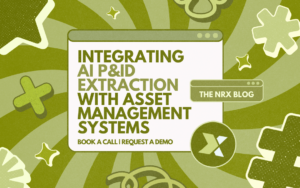According to Deloitte, 40% of an industrial asset’s total cost of ownership is influenced by data quality and lifecycle information. Reliable data extraction during plant walkdowns improves asset verification and helps teams maintain accurate and current asset visibility.

Defining Data Extraction and Its Importance
Data extraction refers to the process of collecting information from physical and digital sources. These may include engineering drawings, inspection sheets, maintenance logs, and photos. When used in a walkdown, this process allows field teams to update and correct digital records. This is especially important during transitions to platforms such as SAP Plant Maintenance. In addition, it strengthens the foundation for functional location accuracy and structured preventive maintenance planning.
The benefit of accurate extraction goes beyond faster updates. Field teams rely on it to minimize human error and confirm that critical information flows into the correct maintenance records. Without it, outdated records often remain in systems. These errors create gaps in PMs and introduce risks for both operations and regulatory reporting.
The Connection Between Data and Asset Verification
Asset verification requires trustworthy and complete data. Any mismatch between digital records and actual asset conditions creates inefficiencies. Maintenance teams can miss scheduled tasks or respond to inaccurate alerts. Safety is also impacted when systems rely on incorrect details.
Consider a pharmaceutical facility that could have faced this issue during a plant walkdown. Field inspectors found that over 20 percent of their functional location data was either incorrect or missing entirely. The team used digital tools to scan codes on equipment and extract data from legacy documents. They corrected asset records and confirmed physical conditions. The updated asset hierarchy made it easier to align PM schedules and avoid unexpected downtime.

Digital Tools Leading the Way
AI-driven software and mobile apps now support field teams during walkdowns. These tools convert paper notes, PDFs, or legacy spreadsheets into usable formats. Some platforms use optical character recognition to extract data from asset tags and labels. The information then links directly to asset records inside an EAM or CMMS system. Features such as geotagging further improve location tracking. By using these tools, teams create reliable records in less time. Now, asset updates reflect the real state of the plant floor.
Challenges and Best Practices
Although promising, data extraction has its challenges. Variations in documentation, poor file quality, or disconnected systems often prevent seamless data collection. One way to limit these setbacks is to begin by organizing all available data in one place. Once gathered, key fields can be reviewed and checked by staff familiar with the plant’s layout and history.
Another important factor is cross-team communication. Successful data verification often depends on close coordination between field staff, engineering teams, and IT support. This collaboration ensures that every extracted detail is mapped correctly to the plant’s functional structure.
Digital Twins and Operational Insight
A digital twin provides a dynamic model of the facility. It depends on accurate asset information to reflect the real environment. High-quality extraction feeds these virtual systems with updated operational context. Walkdowns supported by data tools help create a realistic baseline for simulations and remote diagnostics. Better inputs improve long-term asset performance and enable predictive maintenance. These outcomes support both operational targets and digital transformation goals.
Conclusion
Data extraction is essential to effective asset verification during plant walkdowns. When implemented correctly, it ensures that maintenance platforms reflect the true condition of the field. Clean data strengthens preventive maintenance and supports compliance. Companies planning system upgrades or digital transformations should not overlook the importance of this phase. Every verified asset and corrected FLOC contributes to a more accurate plant model. From field inspections to digital twins, each improvement depends on data that reflects reality.
Integrating AI P&ID Extraction with Asset Management Systems
ISO 14224 vs Other Maintenance Standards: What Sets It Apart?
Building Trust in Your Asset Data: Strategies for Governance
Share this article




